| Columns Retired Columns & Blogs |
Penaudio Serenade loudspeaker Measurements
Sidebar 3: Measurements
The Penaudio Serenade is of slightly below-average voltage sensitivity, at an estimated 86dB(B)/2.83V/m. In general, it is an easy load for an amplifier to drive, but its impedance plot (fig.1) reveals both a minimum magnitude of 3.3 ohms at 85Hz and an awkward combination of 5.9 ohms and –40° electrical phase angle at 55Hz. As music can have considerable energy in this region, a good amplifier rated at 4 ohms should be used. Note the overall disparity between the impedance in the lower midrange and below and in the upper midrange and above. This will boost the treble a little with typical tube amplifiers.
The traces in fig.1 are free from the small wrinkles and discontinuities that would result from cabinet resonances. Investigating the enclosure's vibrational behavior with a plastic-tape accelerometer, I did find some low-level modes at 223Hz, 266Hz, and 531Hz. The first was at its strongest on the sidewall opposite the woofer (fig.2), but these are all sufficiently low in level that they should not give rise to audible problems.
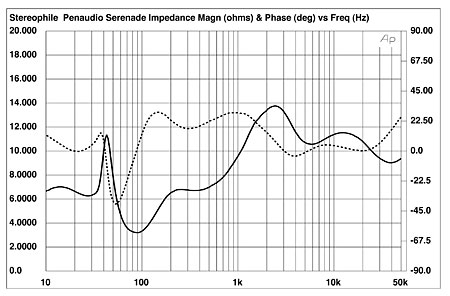
Fig.1 Penaudio Serenade, electrical impedance (solid) and phase (dashed). (2 ohms/vertical div.)
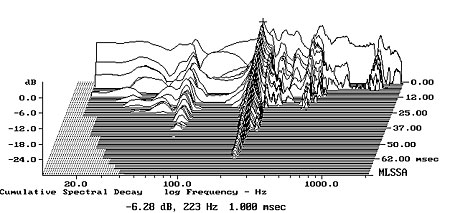
Fig.2 Penaudio Serenade, cumulative spectral-decay plot calculated from the output of an accelerometer fastened to the center of the cabinet's side panel opposite woofer (MLS driving voltage to speaker, 7.55V; measurement bandwidth, 2kHz).
The residual saddle centered on 30Hz in the fig.1 magnitude trace suggests that this is the tuning frequency of the lower port, which reflex-loads the woofer. This port's output, measured in the nearfield with a microphone small enough that it will not impede air flow in the 2"-diameter vent, is shown in fig.3 (magenta trace). It peaks between 30Hz and 50Hz, but is well down in level compared with the nearfield output of the woofer (red). There is almost no sign of the usual reflex notch in the woofer's output, where the back pressure from the port resonance would hold the woofer cone still. The green trace in fig.3 is the nearfield output for the upper port, which appears to load the midrange unit. This covers quite a wide bandwidth, 35–90Hz, and the midrange unit's output (blue trace) shows a sharp reflex notch at 50Hz. Although the midrange unit's response slowly rolls off below 400Hz, it is still active in the upper bass, which is perhaps one reason WP found the Serenade's dynamic range limited.
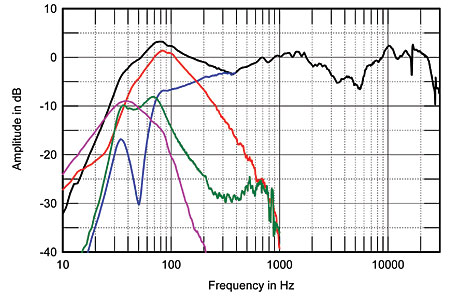
Fig.3 Penaudio Serenade, anechoic response on tweeter axis at 50", averaged across 30° horizontal window and corrected for microphone response (black), with the nearfield responses of the midrange unit (blue), woofer (red), upper port (green), and lower port (magenta), and the complex sum of the nearfield midrange, woofer, and port responses, taking into account acoustic phase and distance from the nominal farfield point (black).
With its woofer, midrange unit, and both ports active at low frequencies, the Serenade's bass behavior is complex. The black trace below 300Hz in fig.3 shows the sum of the four nearfield responses, taking into account acoustic phase and the distance from a nominal farfield microphone position, and with each radiator's contribution scaled in the ratio of its diameter. The midbass peaks by 4dB, this almost entirely due to the nearfield measurement technique. The Serenade's bass extends down to below 40Hz, which is good for a speaker with a relatively small footprint. A slight lack of energy in the lower midrange also showed up in farfield measurements. Of greater concern is the broad, deep suckout between 2kHz and 6kHz on the tweeter axis (which is 42" above the floor). All things being equal, I would expect from this response that the Serenade would sound distant and polite.
Things are rarely equal, however, and, as its plot of vertical dispersion reveals (fig.4), the Serenade's missing presence-region energy does appear at very high or very low listening positions. In WP's room, where he sits quite a long way from the speakers, I suspect that this off-axis contribution influenced the reverberant field so that he was not too bothered by the on-axis suckout (though I felt the nature of the Serenade's highs, which he describes as being "smoother from the upper mids through the ultra-high frequencies" than the Thiel CS2.4's, was due to this misbehavior). However, in a smaller room, or one with more damping of the acoustic, the Penaudio may well sound uninvolving.
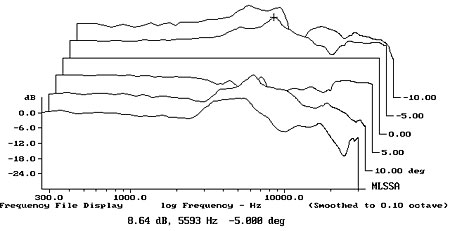
Fig.4 Penaudio Serenade, vertical response family at 50", normalized to response on tweeter axis, from back to front: differences in response 10–5° above axis, reference response, differences in response 5–15° below axis.
In the lateral plane (fig.5), the Serenade's radiation pattern was even and well-controlled, though with more of an off-axis rolloff above 8kHz than I would have expected. To an extent, this will also work against the audibility of the presence-region suckout, by diminishing the contribution to the perceived balance of what, by contrast, might be thought excessive energy in the top audio octave in fig.3. Again, this will have less of an effect on the sound quality in a small, dead room than in a large, reverberant one.
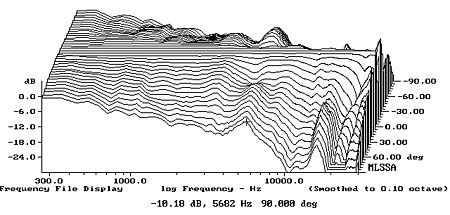
Fig.5 Penaudio Serenade, lateral response family at 50", normalized to response on tweeter axis, from back to front: differences in response 90–5° off axis, reference response, differences in response 5–90° off axis.
In the time domain, the Penaudio's step response on the tweeter axis (fig.6) indicates that both the tweeter and the midrange unit are wired with positive acoustic polarity, though the latter comes in a little early to properly integrate with the former on this axis. Looking at the individual step responses of the tweeter/midrange and woofer sections (fig.7), it is apparent that the woofer (blue trace) is connected in inverted polarity. However, the time delay due to the woofer's being placed on the speaker's side results in its output being in phase with the overhang of the midrange unit's step. All things being equal, this should correlate with good frequency-domain integration of the two units' outputs. I am at a loss, therefore, as to why there is a lack of lower-midrange energy in the Serenade's on-axis response. Finally, the Serenade's cumulative spectral-decay plot (fig.8) is exceptionally clean, though what appears to be a resonance at 16.375kHz might be RF pickup from my PC monitor.
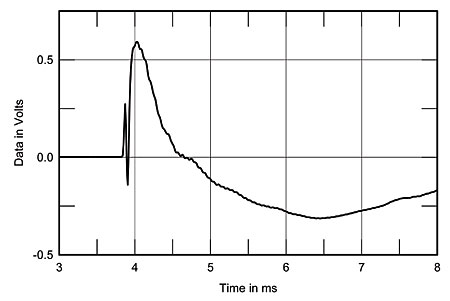
Fig.6 Penaudio Serenade, step response on tweeter axis at 50" (5ms time window, 30kHz bandwidth).
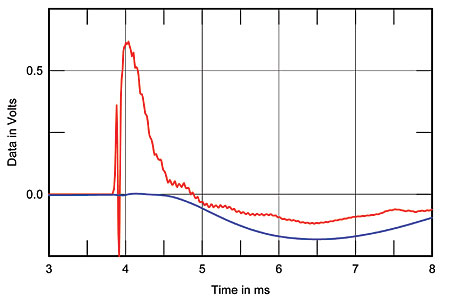
Fig.7 Penaudio Serenade, step response of HF/midrange section (red) and of woofer section (blue) on tweeter axis at 50" (5ms time window, 30kHz bandwidth).
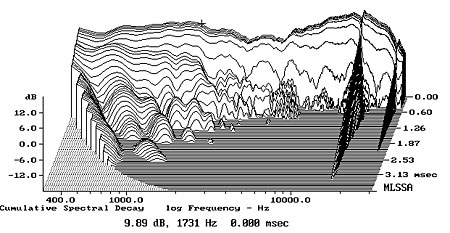
Fig.8 Penaudio Serenade, cumulative spectral-decay plot at 50" (0.15ms risetime).
I found it interesting that Wes wrote, "I tend to listen at low levels a lot, and that's where the Serenade was magic," as the speaker's on-axis response does resemble a loudness-compensation curve at higher frequencies. But overall, I think Penaudio's Serenade too compromised, at least as far its measured performance is concerned, to merit an unconditional recommendation. It appears to be a paradox: a small speaker with somewhat limited dynamic range that will sound its best at low levels in large rooms.—John Atkinson
- Log in or register to post comments




































